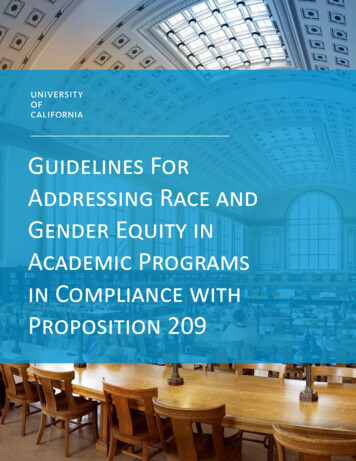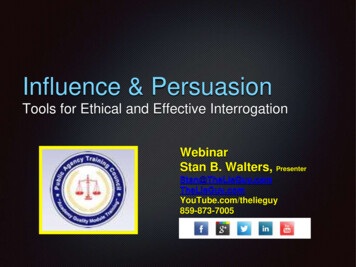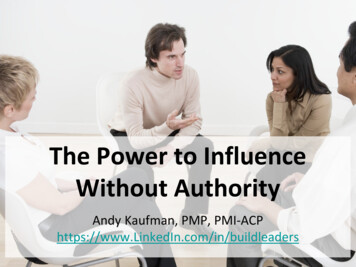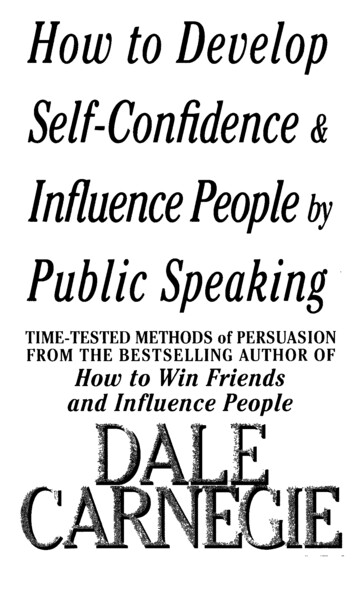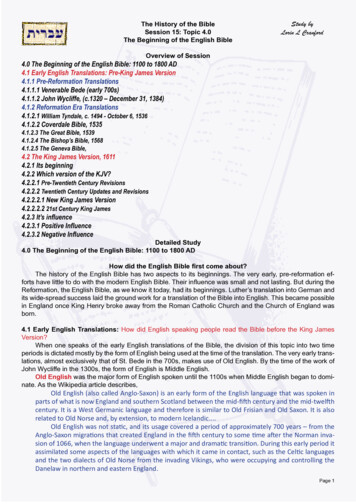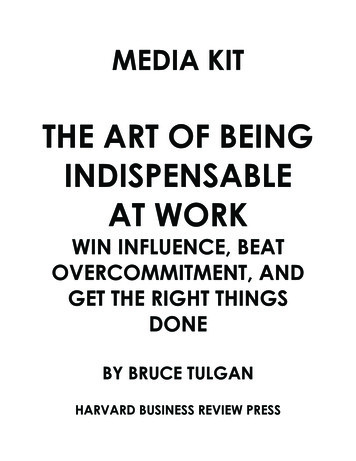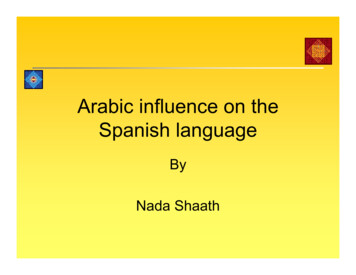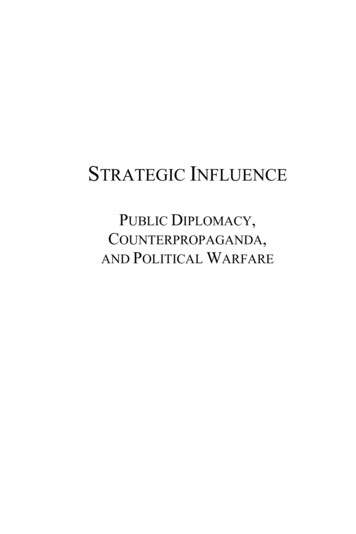
Transcription
STRATEGIC INFLUENCEPUBLIC DIPLOMACY,COUNTERPROPAGANDA,AND POLITICAL WARFARE
Strategic InfluencePublic Diplomacy,Counterpropaganda,and Political WarfareJ. Michael Waller, editorTHE INSTITUTE OF WORLD POLITICS PRESSWashington2008
Strategic Influence:Public Diplomacy, Counterpropaganda,and Political WarfarePublished by the Institute of World Politics Press1521 16th Street NW, Washington DC 20036 USAwww.iwp.eduCover design by Bridget Sweetinwww.sweetin.netCopyright 2008 by the Institute of World Politics PressRevised editionAll rights reserved. With the exceptions of reviewers, students and scholarswho wish to quote brief passages for literary or non-profit purposes, no part ofthis publication may be reproduced or transmitted in any form or by anymeans, by any system now known or to be invented, without the publisher’swritten permission.ISBN-13 978-0-9792-2364-8Other IWP Press titles by the same authorFighting the War of Ideas like a Real WarThe Public Diplomacy Reader
For Katie
To the memory of Ed Wallerand all the other victims of the terrorist bombing in Bali,October 12, 2002
“Our arsenal of persuasion must be as ready as ournuclear arsenal and used as never before.”Edward R. MurrowDirector, U.S. Information Agency, 1963
ContentsIntroduction15Public Diplomacy1. The American Way of Propaganda: Lessons from theFounding FathersJ. Michael Waller262. What ‘Strategic’ Public Diplomacy IsCarnes Lord433. Public Diplomacy and Soft PowerCarnes Lord614. Cultural Diplomacy, Political Influence & Integrated StrategyJohn Lenczowski745. Mediators of the Message:The role of religion and civil society in public diplomacyJennifer Marshall6. Conducting a War of Ideas with Public DiplomacyRobert R. Reilly100120Counterpropaganda7. Counterpropaganda: We Can’t Win Without ItHerbert Romerstein1378. Recovering the Lost Art of Counterpropaganda:An interim assessment of the war of ideas in IraqAndrew Garfield1819. The Interagency Active Measures Working Group:Successful template for strategic influenceHerbert Romerstein197
Political Warfare10. Political Warfare: Means for achieving political endsAngelo Codevilla20611. Getting Psyched: Putting psychology to workto shorten conflicts and save livesMichael Cohn22412. Political War vs. Political Terror:Case study of an American success storyJohn J. Tierney24413. The Importance of WordsJ. Michael Waller14. Hearts and Minds Online:Internetting the messages in the infosphereHampton Stephens269282Toward the Future15. Toward a Theory of Low-Intensity PropagandaStephen C. Baker29516. Red-Teaming Strategic Communications & Political Warfare 325David Spencer17. A Comprehensive Approach to Information OperationsAndrew Garfield34918. Synchronizing Rhetoric, Policy, and ActionJuliana Geran Pilon36819. An Immediate-Term Wartime Message StrategyJ. Michael Waller388About the contributors406
AcknowledgementsThis book is the product of the enthusiastic and diligent work ofmany people. First, I would like to acknowledge and express myappreciation for the research and editorial assistance of some of thegraduate research associates currently or formerly at The Institute ofWorld Politics: Mark Beall, Shawn Brimley, Erin Carrington, JayGress, Bryan Hill, Amleset Kidane, Mallorie Lewis, Brian NewsomeCharles Van Someren and Nicole Villescas. They did the hard part: thecopy editing, formatting and chasing down of details.I would also like to thank Alex Alexiev, Jim Guirard, StephanieKinney, Michaelis Persianis, and IWP Professors Juliana Geran Pilonand Douglas Streusand for their many ideas, insights and expertise thathelped shape the direction of this volume.Professor Herbert Romerstein, author of two chapters on counterpropaganda, wishes to thank Dr. Klaus Kirchner for his valuable adviceand for help in obtaining some or the rare World War II leaflets cited inChapter 7. Dr. Kirchner is the author of 15 volumes on World War IIleaflets and two on World War I. He donated all 17 volumes to thelibrary of the Institute of World Politics. Prof. Romerstein would alsolike to thank Elinor and Tom Wright, Henry Durkin and Dick Markelfor help with German translations, Dmitry Kulik for help withtranslation from Russian and Ukrainian, and Lawrence Peck for helpwith Korean translations.Lastly, I wish to thank John Lenczowski, President of The Instituteof World Politics, for his unfailing support of this project since it beganas an idea exchanged in passing on the staircase.
IntroductionWhy do we twist ourselves with angst at the thought of secretlyplacing truthful, positive stories about our military in the beleaguerednewspapers of a country where we are at war? Why do innovations like“strategic influence” abroad to help our friends and defeat our enemiesprovoke such emotional opposition at home? Why is such outrage somuch greater than the sorrow that our errant bombs or bullets killinnocent civilians in what we mechanically call collateral damage?Why do we prefer to have our troops killed than use strategic influenceas an effective weapon?Such disjointed logic defies human decency.As the United States struggles to shape coherent messages to theworld, it must form not only the means through which it delivers itsideas, but the very philosophy of how it wages a “war of ideas.” Thenear-universal default is “more public diplomacy” – the U.S.government’s communication with the publics of the world – withoutreally knowing the limits of public diplomacy and the many otherhumane, non-lethal options available to assist our diplomats andwarfighters. But saying we need more public diplomacy is like sayingwe can alleviate world poverty if only we spent more on foreign aid, orwin wars through the application of greater military force. Sheervolume is not the answer.Our public diplomacy approaches and applications are inconsistentwith the realities of today’s international environment. Advances ininformation technology and the proliferation of electronic media outletshave leveled the ground between the U.S. and small powers, nongovernmental organizations, and even individuals, who can undermineWashington’s carefully crafted messages rapidly and constantly,networking horizontally and virally, attacking in swarms and refuting,distorting and drowning out the American voice, and agitatingincreasingly shrill and even deadly opposition.Public diplomacy and the far broader field of strategiccommunication, as developed, are missing key components andfunctions. Lacking are roles and capabilities between the soft policiesof attraction and the lethal policies of military force. A wide void spans15
16STRATEGIC INFLUENCEthe two – a void easily filled, as it has been in the past, but with fewtrained practitioners and even fewer policy advocates. Yet that void isprecisely where the enemy is fighting the war of ideas. Within that grayarea the U.S. and its allies would be expected to wagecounterpropaganda and political warfare to substitute or augment themilitary.Military transformation has been a cornerstone of the United States’ability to fight the latest generations of terrorists and insurgents. The9/11 Commission mandated a similar revolution in the intelligencecommunity. Yet the owner of one of the key elements of fighting thewar of ideas – the State Department – has made only the mostrudimentary of attempts to transform its cumbersome diplomaticprocesses and its ineffective public diplomacy machinery since the2001 attacks.Mentalities and institutions that served well during the Cold War arenot necessarily what the country needs today, but many of the triedand-true Cold War strategies and tactics provide invaluable lessons thatdeserve careful – but quick – study and consideration. Many of thetimeless means and methods used successfully in the last majorideological conflict can be applied to today’s geopolitical changes,cultural shifts, technological advances, and asymmetries of insurgencywarfare.Which brings us to the purpose of this book. Strategic Influence is acollection of 19 essays meant to help orient a more integrated, holisticapproach to winning the “battle of hearts and minds” and “war ofideas.” Those terms have become clichés, but they accuratelycharacterize the type of global conflict underway. That is why one findsit strange that the public diplomacy community has yet to engage asone would expect in time of battle or war; its leaders and its rank-andfile have done the political equivalent of getting themselves repeatedlywounded and killed in battle (when they have engaged at all), andfrequently commit fratricide against the troops and themselves througha lack of urgency, poor planning, inadequately trained personnel, and ageneral approach more of trepidation than innovation.One cannot consider public diplomacy strategy or strategiccommunications outside the context of diplomatic grand strategy. Nogrand strategy can exist apart from military strategy, and a militarystrategy with a weak information and influence component will fail inmodern ideological warfare. In counterterrorism and counterinsurgency, most of the fight is psychological and political. “Thepolitical and military aspects of insurgencies are so bound together asto be inseparable,” the U.S. Army says in its 2006 Counterinsurgencyfield manual. “Most insurgent approaches recognize that fact. Military
Introduction17actions executed without properly assessing their political effects atbest will be reduced in effectiveness and at worst arecounterproductive. Resolving most insurgencies requires a politicalsolution; it is thus imperative that counterinsurgent actions do nothinder achieving that political solution,” according to the manual. TheArmy’s 2008 Stability Operations field manual integrates civil andmilitary affairs even further, to win the peace after winning wars, andto prevent wars from taking place at all.Like it or not, then, the U.S. must conduct its public diplomacy withwar aims in mind – even though much of the activity will properly havelittle or nothing to do with the war at all. Diplomacy and publicdiplomacy must strongly support, to say nothing of not undermine,military actions. Military efforts, the Counterinsurgency field manualnotes, “are only effective when integrated into a comprehensivestrategy employing all instruments of national power.”Strategic communications, a means of exercising strategic influence,are for all the time, not simply in time of crisis or military conflict.Much remains before the United States and its allies develop a realstrategic communication doctrine – or even better, a doctrine onstrategic influence.Until now, most official talk of fighting and winning a war of ideasas a national strategy has been little more than empty or misguidedrhetoric. Public diplomacy, the art and practice of governmentscommunicating with the people of other countries, is an importantcomponent of a comprehensive ideological strategy. As vital as it is,public diplomacy is commonly proffered as a throwawayrecommendation or miraculous catch-all for what we need in thepresent conflict. But it is only a single tool in the arsenal of democracy.The State Department has flailed and floundered since 9/11 to dominatethe public diplomacy function that its own foreign service neitherwanted nor understood. Consequently the diplomatic corps hasexhibited a pattern of success that generally is inversely proportional tothat of the military. The military has done its job to neutralize anddestroy the enemy. But the State Department has not done its job on thewar of ideas front, despite the near-total bipartisan mandate and newlaws for it to do so.That fact was obvious from the beginning, which is why the Officeof the Secretary of Defense took it upon itself a month after 9/11 to fillthe void. Ultimately it settled for a “public diplomacy support” role(diplomatically pretending that there was much public diplomacy tosupport in the first place), but not before expanding a concept called“strategic influence.” Recognizing in October 2001 that the war againstIslamist extremism and next-generation conflict at large would be won
18STRATEGIC INFLUENCEor lost on the influence front, the Pentagon set up a small Office ofStrategic Influence (OSI) to carry out influence operations abroad. OSIwas meant not only to support combat operations, but ultimately to helplimit the need for using military force, and even mooting the use offorce at all. The Office was able only to launch a few initiatives, allwith the support for the Under Secretary of State for Public Diplomacy,to limit the need for using military force and even to solve militaryproblems without killing and destroying.Yet woe to those who dared innovate in time of national emergency!OSI’s creative efforts showed promise, for a brief moment, to workwell in support of the war against the terrorists, receiving fullinteragency support. There was only one snag: A political appointeewho admitted that she had no knowledge of the military, but whodecided that the effort encroached on her turf.That appointee was the Assistant Secretary of Defense for PublicAffairs – the Pentagon spokeswoman herself. She leaked a misleadingand inflammatory story to the New York Times, alleging falsely thatOSI was in the disinformation business and that it would undermine thewar effort. Abusing her authority, she forbade OSI officials fromspeaking to reporters while she spun her false version of the truth. Theresultant one-sided controversy ballooned over a three-day weekend inearly 2002. Neither the president nor the defense secretary was briefedto defend OSI, and the office, contaminated by the emotionalcontroversy and barred from explaining itself, was promptly shut down.While the administration continued to support the concept of strategicinfluence, the bureaucracy and contractors scattered, and the initiativenever fully recovered. An audit at Senator Carl Levin’s request laterdisproved the New York Times story, but the damage was done.Meanwhile, an independent Pentagon panel, the Defense ScienceBoard, worked on a government-wide “strategic communication”concept. In 2004 the board issued an innovative report that stated inpart,Strategic communication requires a sophisticated method that mapsperceptions and influence networks, identifies policy priorities,formulates objectives, focuses on ‘doable tasks,’ develops themes andmessages, employs relevant channels, leverages new strategic andtactical dynamics, and monitors success. This approach will build onin-depth knowledge of other cultures and factors that motivate humanbehavior. It will adapt techniques of skillful political campaigning.The board’s report continued, “We need to move beyond outdatedconcepts, stale structural models, and institutionally-based labels.
Introduction19Public diplomacy, public affairs, PSYOP [psychological operations]and open military information operations must be coordinated andenergized.” The panel made recommendations for “changes in thestrategic communication functions and structures of the Departments ofState and Defense, U.S. embassies and combatant commands.”The State Department went along reluctantly, but came up with notransformational plan of its own. State’s inaction made the Pentagonthe chief innovator on strategic influence, though most publicdiplomacy professionals are adamant that the involvement of the armedforces in public diplomacy and related areas should be minimal. Manysenior military officers seem to agree. Despite similarities and overlaps,there is a difference between civilian public diplomacy and militaryinformation operations – a difference to be maintained for the integrityand success of both. And both depend on the success of one another.Furthermore, both are but two elements of strategic influence as awhole, a field that also includes counterpropaganda and politicalwarfare, as this book’s title implies, as well as charitable, cultural,economic, ideological, legal and psychological means of influencingaudiences around the world.The Defense Science Board report was the most important first stepthe federal government took after 9/11 to improve the way the nationcommunicates with the world. However, even later versions miss somekey elements for a successful strategic influence capability, showingthe limitations of “strategic communication” without influence as thecore principle. The Army’s 2006 Counterinsurgency Field Manualthoroughly re-examines insurgents and the means of defeating themand includes elements of strategic influence as central components.This book is a contribution toward broadening the understanding ofstrategic influence and filling the ideational void. Fourteen experts, allof them current or former practitioners in their fields or emergingscholars with innovative approaches, offer their own perspectives ofvarious forms of strategic communication and influence. This bookdoes not seek to ask all the questions or claim to have all the answers.Its purpose is to stimulate discussion, thought, and action, and serve asa general textbook reader on the subject.The authors bring together a diversity of disciplines: diplomats,public diplomats, broadcasters, congressional and White House staff,military officers, intelligence and counterintelligence officers,journalists, academics, counterpropagandists, political and policyoperatives, and leaders of non-governmental organizations. Some havebackgrounds in psychology and law. Many have served on the groundand in the field in times of war and peace. Others bring experiencefrom the national strategic level. Their service and experience ranges
20STRATEGIC INFLUENCEfrom the opening of the Cold War to present-day Iraq and Afghanistan.The views expressed in each chapter are those of the respective author,and do not represent the views of their employers, other authors, or thiseditor.Public diplomacy, counterpropaganda, and political warfare are partof the American diplomatic and national security tradition. Theirwidespread use dates to the founding of the republic. In Chapter 1, theeditor of this volume looks at the use of all three instruments incountering the might and wealth of the British Empire during theAmerican Revolution, showing how a rather divided set of colonieslacking a strong military could take on and defeat the mightiest powerin the world. The chapter not only puts the subject of the book into itsproper historical context, but also illustrates how an inferior militaryforce can use information, political, and psychological strategy to wagea successful asymmetrical warfare campaign. The study of the foundingshows how a combination of gentle public diplomacy with toughpolitical and psychological warfare at the heart of the Americanmilitary and security tradition.Carnes Lord, former national security advisor to the vice presidentof the United States and presently a professor of strategy at the NavalWar College, sets the tone in the next two chapters, explaining inChapter 2 what public diplomacy is, what it was and how it worked inits heyday, and how it should function as a strategic tool. Having beenan author and practitioner on the subjects of public diplomacy andpsychological warfare for more than two decades – he was the primaryauthor of President Reagan’s National Security Decision Directive No.77 on the management of public diplomacy with regard to nationalsecurity – Lord elaborates in Chapter 3 on public diplomacy and itsrelationship to “soft power,” expanding the field by describing thedifference between the policies of attraction and influence. These twochapters have appeared elsewhere in modified form but werecommissioned specifically for this book.In Chapter 4, John Lenczowski builds further on the architecture,commenting elegantly on cultural diplomacy, political influence, andintegrated strategy. As an advisor to the undersecretary of state at theconception of the successful strategy to take down the Soviet Union, hewas an early proponent of strategic cultural diplomacy as an instrumentof friendship as well as a weapon to undermine adversaries throughpositive and peaceful means. He went on to serve seven years asdirector of European and Soviet affairs at the White House NationalSecurity Council before ultimately founding the Institute of WorldPolitics, the graduate school that produced this book.Moving into today’s conflict versus Islamist extremism, Jennifer
Introduction21Marshall devotes Chapter 5 to discussing the role of religion and civilsociety in public diplomacy, and offers a model to help the U.S. prevailin the war of ideas by understanding the role of religion in othercultures as well as our own. As director of domestic policy studies anddirector of the Richard and Helen DeVos Center for Religion and CivilSociety at the Heritage Foundation, she oversees research and publicpolicy programs that include religion and civil society.Robert R. Reilly, a former senior official in the White House andDepartment of Defense who served as a director of the Voice ofAmerica, devotes Chapter 6 explicitly to “how to conduct a war ofideas.” He was a contributor to the Defense Science Board’s strategiccommunication reports. In Chapter 6, Reilly offers sharp but thoughtfulcriticism of how that war was – or was not – waged in the yearsfollowing 9/11, discussing bureaucratic mentalities and structuraldysfunctionalism, and explaining that our officials first mustunderstand our own nation’s ideas and the ideas of our enemies.We then move from public diplomacy to the actual countering ofadversarial and enemy propaganda. Here, history has much to teach us.During the Cold War years, the United States government did notregularly combat Soviet disinformation and active measures until 1981,after congressional committees forced the issue into the public. Bythen, for the first time since the Truman and Eisenhoweradministrations, U.S. leaders re-recognized the importance ofchallenging Soviet propaganda directly and at the highest levels.Herbert Romerstein, a professional staff member of the HousePermanent Select Committee on Intelligence, later became head of theOffice to Counter Soviet Active Measures at the U.S. InformationAgency (USIA).In Chapter 7, Romerstein describes the indispensability ofcounterpropaganda in the war of ideas, reaching back to World War IIto look at ways in which the Americans and British countered Nazipropaganda, especially among troops and civilians on the ground, andlater countered the Soviets. He reminds us that by our own bad policiesand methods, we can unintentionally play into the propagandacampaigns of our enemies, only to become surprised that we have tocounter so much hostility among the people we try to reach.Fast-forward to recent years in Chapter 8, where Andrew Garfieldassesses the war of ideas in Iraq. Garfield is a former senior advisor tothe British Ministry of Defence and a senior fellow at the ForeignPolicy Research Institute in Philadelphia, and a founding partner ofGlevum Associates, an international communication consulting firmthat is on the cutting edge of influence warfare theory and practice. Hedesigned sophisticated information operations in Iraq, but found that
22STRATEGIC INFLUENCEthe American and coalition approach to influence operations was shorton creativity and long on excuses about why things cannot be done.Writing before the 2007 surge, Garfield says, “From firsthandexperience in Iraq, I can only conclude that we are losing not simplythe physical battle but perhaps even more importantly the psychologicalconflict.” The success of the changed strategy in Al-Anbar province –the change that produced the counterinsurgency and stability operationsdoctrines – proved Garfield’s points, but systemic challenges remain.Garfield makes a case for aggressive information operations andeffective, properly coordinated counterpropaganda.If the military has done its job from below, what can U.S. civilianleaders do from the top? Senior military officers tell this editor thatthey want and need more civilian leadership and direction in theinfluence field. Herb Romerstein is back in Chapter 9, describing howthe U.S., in the last years of the Cold War, set up and ran a successfulcounterpropaganda process at the national strategic level. Based at theWhite House, the Interagency Active Measures Working Group wasthe Reagan administration’s government-wide counterpropagandacoordinating body against the Soviets. Romerstein was there at thefounding as USIA representative on the working group. Despite today’svery different world circumstances, the working group providesinsights into how a president can structure an effectivecounterpropaganda coordinator. Romerstein teaches defenses againstforeign propaganda at the Institute of World Politics.Merely countering what the enemy says and does would put theU.S. and its allies on the permanent defensive, leaving the initiative tothe enemy. This is where political warfare, for lack of a better term,comes into play. Political warfare is the civilian analogue to themilitary’s psychological operations (PSYOP) and informationoperations (IO). In Chapter 10, Boston University Professor AngeloCodevilla gives a primer on political warfare as both an instrument ofpower and an art form. “Political warfare,” he writes, “is the art ofheartening friends and disheartening enemies, of gaining help for one’scause and causing the abandonment of the enemies’ through words anddeeds.”To master the political, one must first know how others think, andhow to take advantage of both universal human nature and specificcultural and even microcultural mindsets. That is why Michael Cohn inChapter 11 advocates that American public diplomats, intelligenceofficers and warfighters master the use of psychology in waging thewar for hearts and minds. Writing as a research associate at the Instituteof World Politics, Cohn takes basic college psychology texts andapplies them in his chapter to how the good guys can hearten friends
Introduction23and dishearten enemies through skillful mind-gaming.The U.S. has succeeded in wartime psychological strategy, evenagainst those who use terror. IWP Professor John J. Tierney providescase studies in Chapter 12 of two American success stories, both takingplace in the Philippines. The first occurred in the early 20th centurywhen obsolete military thinking and misperceptions helped giveinsurgents the edge in the Philippine Insurrection. Tierney shows howPresident William McKinley “had to fight a two-front campaign” – apolitical war against domestic anti-war groups and his oppositionpolitical party, and the Philippine insurgents themselves who, in 1900,tried to use the war to influence the American presidential election. Thesecond took place after World War II when the CommunistHukbalahaps, who had been fighting the Japanese, turned on the UnitedStates. In both counterinsurgencies the U.S. used “policies ofattraction” to win local support and defeat the guerrillas.A successful policy of attraction depends on the judicious use ofwords. Words can have many meanings, and can be as repulsive asattractive. When not used wisely, words can be as destructive as anyconventional weapon. In Chapter 13, this writer looks at how words areused as instruments of conflict and weapons of war, how meaningsdiffer among languages and cultures, and sometimes within the sameculture; how we unwittingly adopt the terminology of our adversariesto the detriment of our allies, and how we can take the vernacular backfrom the enemy and make it work for the present war effort and in thelong-term.America’s adversaries have harnessed U.S. communicationtechnology, using satellites and servers, to globalize their ideologies,spread their propaganda, and coordinate their operations. HamptonStephens of WorldPoliticsWatch.com compares the agility anddecentralization of terror networks and extremist movements andcompares them in Chapter 14 with the centralized slowness of U.S.message-makers, remarking on the paradox that the highly authoritarianPeople’s Republic of China has nimbly captured the power of theInternet to its advantage. Stephens argues that the only factorspreventing the U.S. from reversing the problem are bureaucratic inertiaand lack of political will.The last six chapters look to the future. Chapter 15 takes lowintensity conflict theory and applies it to fighting enemy propaganda.Stephen C. Baker, who was with the Center for Security Policy and anIWP graduate student when he developed the theory of “low-intensitypropaganda,” argues that the U.S. and its allies must combat enemypropaganda on the civilian and politico-military levels with as muchenergy and drive as a traditional counterinsurgency force. This chapter
24STRATEGIC INFLUENCEshould be particularly useful for those intending to expand newcounterinsurgency doctrine, but is important for diplomats, publicdiplomats, and public affairs officers as well.National Defense University Professor David Spencer follows withan analysis of certain terrorist insurgency doctrine and calls for thestrategic communications community to “red team” their plans andtheories. Red teaming is the term used by the U.S. when portrayingadversarial forces in war games or simulations. The U.S. and its alliesare blue, the enemy is red, and other parties and NGOs are green. Redteaming helps the U.S. understand the adversary and troubleshoot itsown thinking and practices. Spencer argues in Chapter 16 that the StateDepartment has been mistaken in not taking the lead in gaming and redteaming, choosing instead to leave the matter up to the military. Headds that the Pentagon should game out its own strategiccommunication and information operations. “We can see the resultstoday,” Spencer writes: “Superior military strategy and tactics over anyfoe, but grossly inadequate public diplomacy, political warfare, andinformation strategy at a time when warfare more than e
and for help in obtaining some or the rare World War II leaflets cited in Chapter 7. Dr. Kirchner is the author of 15 volumes on World War II leaflets and two on World War I. He donated all 17 volumes to the library of the Institute of World Politics. Prof. Romerstein would also like to thank Elinor and Tom Wright, Henry Durkin and Dick Markel

